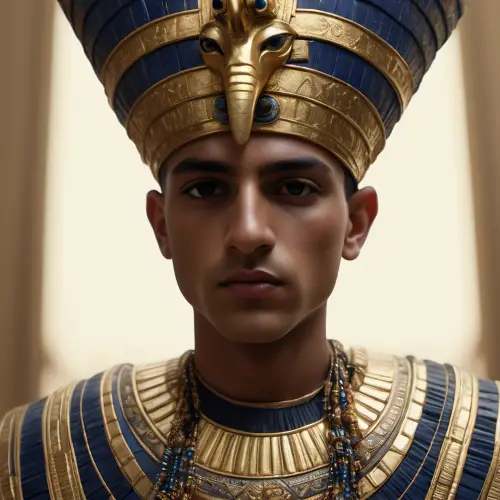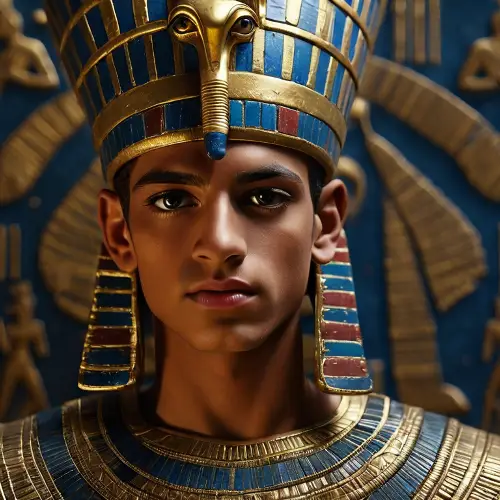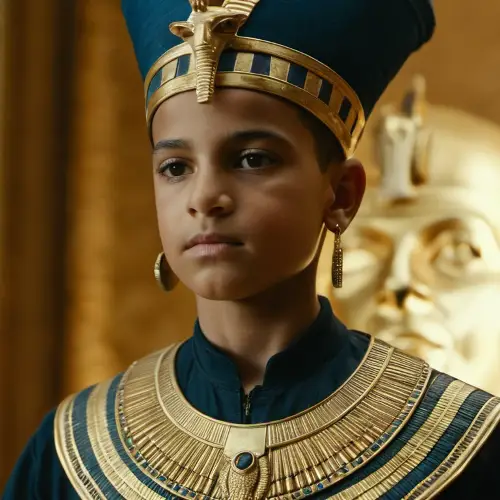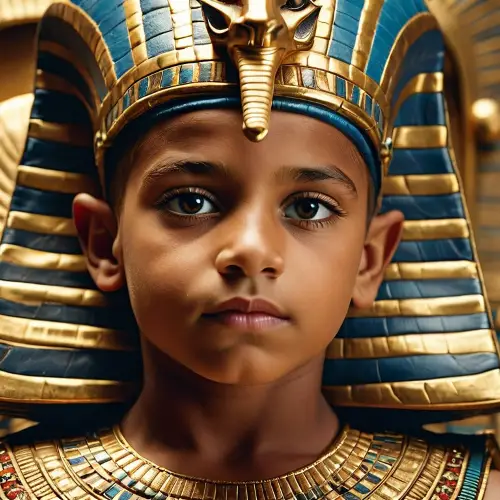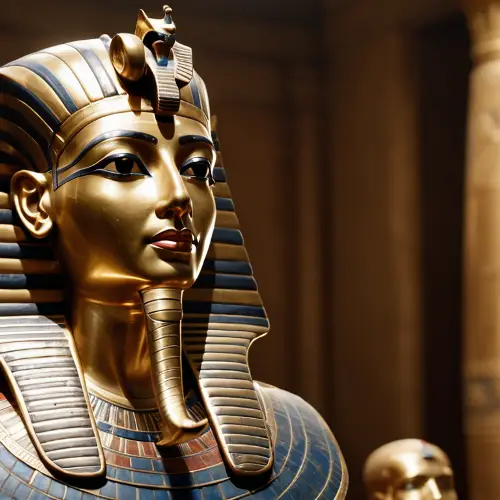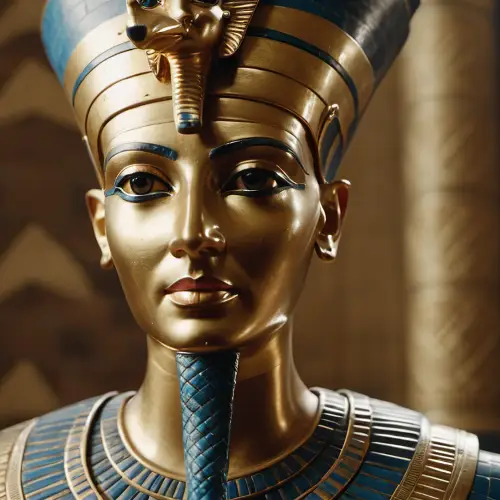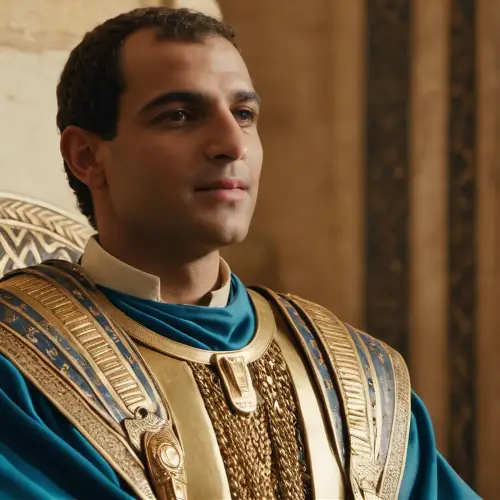A youthful Tutankhamun, Pharaoh of Egypt, portrayed in his early years. He stands with regal grace, adorned in ornate garments reflecting the opulence of ancient Egyptian royalty. The intricate details of his attire and the grandeur of his headdress symbolize the power and splendor of his reign.
More Like This
A youthful Tutankhamun, Pharaoh of Egypt, portrayed in his early years. He stands with regal grace, adorned in ornate garments reflecting the opulence of ancient Egyptian royalty. The intricate details of his attire and the grandeur of his headdress symbolize the power and splendor of his reign.
Pharaoh Tutankhamun, the 10th ruler of Egypt's 18th dynasty, depicted in his majestic regalia, adorned with the traditional Egyptian crown and intricate jewelry. The young pharaoh, known for his reign during the New Kingdom, stands with an air of royal authority, symbolizing the grandeur of ancient Egypt.
Pharaoh Tutankhamun, the 10th ruler of Egypt's 18th dynasty, depicted in his majestic regalia, adorned with the traditional Egyptian crown and intricate jewelry. The young pharaoh, known for his reign during the New Kingdom, stands with an air of royal authority, symbolizing the grandeur of ancient Egypt.
Pharaoh Tutankhamun, the 10th ruler of Egypt's 18th dynasty, depicted in his majestic regalia, adorned with the traditional Egyptian crown and intricate jewelry. The young pharaoh, known for his reign during the New Kingdom, stands with an air of royal authority, symbolizing the grandeur of ancient Egypt.
Tutankhamun seated on the throne. In a regal setting, the young pharaoh exudes authority, adorned with royal attire and the symbols of power. The scene captures the essence of his reign as he sits majestically on the throne.
Tutankhamun seated on the throne. In a regal setting, the young pharaoh exudes authority, adorned with royal attire and the symbols of power. The scene captures the essence of his reign as he sits majestically on the throne.
Pharaoh Tutankhamun adorned in a golden crown, wearing a symbolic cobra-shaped headdress embracing his shoulders. His face depicted with intricate eyeliner, a thick beard, and smooth skin. Clad in a lavish golden garment that drapes his body.
Tutankhamun, ascending to the throne at the age of 9, dons the regal attire of an Egyptian pharaoh, his youthful visage illuminated by the ancient splendor of Egypt.
A vivid portrayal of Pharaoh Tutankhamun reigning over Egypt from 1334 BC to 1325 BC. The scene includes the Pharaoh's regal presence and the diverse populace of Egypt.
An artistic representation of Pharaoh Tutankhamun reigning over Egypt from 1334 BC to 1325 BC.
An artistic representation of Pharaoh Tutankhamun reigning over Egypt from 1334 BC to 1325 BC.
When Tutankhamun is alive, the scene where he wears a mask and attends the succession ceremony. The collars of Nemes on both sides of the mask represent the authority of the pharaoh, and the cobras and eagles on the foreheads symbolize the goddesses of Egypt and the Sanga.
The iconic image of Tutankhamun in the center of ancient Egypt, his visage immortalized in the famous bust, embodying the mystique and allure of the pharaohs.
Illustrating the mystery surrounding Tutankhamun's death, envision the young pharaoh lying peacefully in his burial chamber, surrounded by the treasures of his reign. The dim glow of flickering torches reveals the intricate details of his funeral mask, symbolizing both regality and the journey to the afterlife. An air of solemnity lingers as historians ponder the secrets concealed within the ancient tomb.
Tutankhamun's majestic crown, adorned with various jewels, emphasizes his grandeur.
Tutankhamun with a congenital genetic disorder. In a regal setting, the young pharaoh is depicted with a frail physique, illustrating the impact of his congenital condition. Advisors and attendants observe, reflecting the challenges Tutankhamun faced due to his weakened health.
Tutankhamun's coronation ceremony at the age of 9, adorned in royal regalia, captures the grandeur of ancient Egypt.
Tutankhamun issuing commands from the throne. In a commanding stance, the pharaoh directs with authority, surrounded by an air of regality. The scene captures the essence of leadership as Tutankhamun rules from his throne.
Unveiling Tutankhamun's funeral golden mask, the intricate details of the ancient Egyptian craftsmanship are revealed. The golden sheen reflects the regality of the young Pharaoh, and the delicate features are a testament to the artistry of a bygone era.
Tutankhamun, amidst opulent surroundings, gracefully leans on a staff embellished with precious jewels, showcasing scenes of him using the staff to navigate majestic halls, ascending grand staircases, and presiding over regal ceremonies. The staff, adorned with intricate hieroglyphics, becomes a symbol of his royal presence.
Tutankhamun's two daggers,Sharp and gleaming,Adorned with golden embellishments,Symbolizing the power of kings.A legend in history,Preserving the glory of Egypt,With grace and elegance,Instilling awe.Capture through my camera,Detailing meticulously,The radiant light and shadows,In the moment with Tutankhamun.
Archaeologists unveil the ancient burial mask of Tutankhamun, a golden relic that echoes the regal essence of the young Pharaoh. The delicate features, intricately crafted by ancient Egyptian artisans, come to light as the mask is carefully revealed.
Archaeologists unveil the ancient burial mask of Tutankhamun, a golden relic that echoes the regal essence of the young Pharaoh. The delicate features, intricately crafted by ancient Egyptian artisans, come to light as the mask is carefully revealed.
In the vibrant spring of 51 BCE, bathed in the warm glow of sunlight, the young Ptolemy XIII assumes his fathers mantle as the Pharaoh of Egypt. His face, a mixture of youthful innocence and the weight of responsibility, reveals the essence of a burgeoning leader.Seated beside him on the throne, Cleopatra, his sister and co-ruler, the epitome of regal grace, signifies unity and strength. Their marriage becomes a symbol of power and consolidation, promising to guide Egypts destiny hand in hand. The scene encapsulates the tender moment of an alliance, where two hearts, still in their formative years, pledge to grow together.
The discovery of the ancient mummy of Tutankhamun unfolds. As the archaeologists carefully unveil the layers of linen and wrappings, the preserved features of the young Pharaoh emerge, showcasing the artistry of ancient Egyptian embalming. The dimly lit chamber adds an aura of mystery and reverence to the moment.
The discovery of the ancient mummy of Tutankhamun unfolds. As the archaeologists carefully unveil the layers of linen and wrappings, the preserved features of the young Pharaoh emerge, showcasing the artistry of ancient Egyptian embalming. The dimly lit chamber adds an aura of mystery and reverence to the moment.
Tutankhamun's coronation ceremony at the age of 9 unfolds with the young pharaoh's regal back view, surrounded by the bustling crowd in the royal palace.
A scene illustrating the side view of 9-year-old Pharaoh Tutankhamun delivering a speech in front of a vast crowd.
Vast desert sands stretch as far as the eye can see, enveloping the banks of the Nile river in a golden haze. Upon the water glide ornate wooden vessels, their painted sails catching the northern breeze as oarsmen guide their way. Along the shore, figures toil - harvesting grain, drawing water, crafting wares under the watchful gaze of the Sphinx. All pay tribute to the great kings who granted this verdant strip of civilization. And towering above the dusty villages, the stepping stones of Giza jut proudly into the sky, a monument to past rulers and a reminder of Egypt's eternal nature. It is here in this timeless landscape that Pharaoh Tutankhamun reigns, overseeing an empire that has endured for millennia.
Emerging from the shadows, a radiant glow unveils the presence of Tutankhamun. The play of light accentuates the mysterious aura surrounding him, creating an enigmatic and captivating atmosphere.
Emerging from the shadows, a radiant glow unveils the presence of Tutankhamun. The play of light accentuates the mysterious aura surrounding him, creating an enigmatic and captivating atmosphere.
December 4, 1922. Deep beneath Egypt's sands, Howard Carter's lamp illuminates a discovery history can never forget. His breath catches at glints in the darkness - golden rays and hieroglyphs frozen since time began. As he brushes away dust from mysteries left sealed, gasps echo in that crypt where none have walked for millennia. For where he sweeps reveals not crumbling bones but solace everlasting. Gentle hands fold back shrouds with care that knows this pharaoh needs no crown, only calm forevermore. And there do the watchers see, as in dreams, a boy-king's visage undimmed through all the circlings of the sun. A nation's gift shown bright once more for eyes anew to take in Tutankhamun - pharaoh no longer lost but found, in still repose under Time's veil, regal guardian of tombs that hold fast the ancient world entire.
Tutankhamun with distorted feet and pelvis due to a genetic disorder. In a solemn depiction, the pharaoh exhibits the effects of his inherited condition, showcasing distorted feet and a misshapen pelvis. The scene captures the challenges he faced with grace in the context of his royal role.
Tutankhamun using a cane due to distorted feet and pelvis caused by a genetic disorder. In a poignant scene, the pharaoh is portrayed relying on a cane for support, emphasizing the impact of his inherited condition. The regal figure perseveres, symbolizing strength amid physical challenges.
Tutankhamun using a cane due to distorted feet and pelvis caused by a genetic disorder. In a poignant scene, the pharaoh is portrayed relying on a cane for support, emphasizing the impact of his inherited condition. The regal figure perseveres, symbolizing strength amid physical challenges.
Tutankhamun using a cane due to distorted feet and pelvis caused by a genetic disorder. In a poignant scene, the pharaoh is portrayed relying on a cane for support, emphasizing the impact of his inherited condition. The regal figure perseveres, symbolizing strength amid physical challenges.
Tutankhamun using a cane due to distorted feet and pelvis caused by a genetic disorder. In a poignant scene, the pharaoh is portrayed relying on a cane for support, emphasizing the impact of his inherited condition. The regal figure perseveres, symbolizing strength amid physical challenges.


